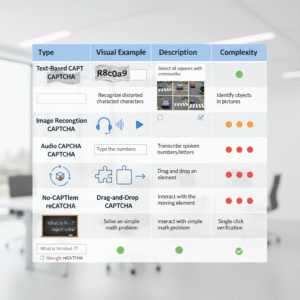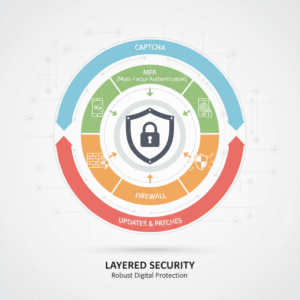What is CAPTCHA?
Understanding Its Role, Vulnerabilities, and How to Protect Your Devices
What is CAPTCHA and Why Do We Use It? Can It Be Vulnerable and How Can You Protect Your System or Gadgets

Imagine browsing your favorite website, and right before you log in, you’re asked to identify traffic lights or type out some distorted characters. Slightly annoying? Yes. But this small step is actually a powerful security mechanism keeping digital bots and malicious actors at bay. This system is called CAPTCHA.
In this article, we’ll explore what CAPTCHA is, why we use it, its possible vulnerabilities, and how you can protect your systems or gadgets from new-age threats. By the end, you’ll not only appreciate the role of CAPTCHA in cybersecurity but also know how to stay one step ahead of attackers exploiting these defenses.
Understanding CAPTCHA: The Basics
The acronym CAPTCHA stands for Completely Automated Public Turing test to tell Computers and Humans Apart. It was introduced in the early 2000s to solve a simple problem — ensuring that only humans can perform certain online activities, not automated scripts or bots.
At its core, CAPTCHA is a challenge-response test. A system presents a random task that’s usually very simple for humans but hard for machines to solve. By passing the test, the user proves they’re a real person.
Common Functions of CAPTCHA
-
Prevents spam registrations on websites.
-
Stops automated login attempts by brute-force bots.
-
Protects comment sections from fake or junk content.
-
Guards online polls to maintain fairness.
-
Minimizes ticket-scalping attacks on booking portals.

Types of CAPTCHA
Over the years, CAPTCHAs have evolved significantly. Early designs consisted of blurry texts, while modern ones may involve AI-driven interaction. Here are the most common types:
1. Text-based CAPTCHA
The user must type distorted letters or numbers shown in an image. This was one of the earliest forms but is now less secure due to advanced image recognition.
2. Image-based CAPTCHA
Users identify specific objects (cars, crosswalks, traffic lights) from a grid. This is common on popular services like Google.
3. Audio CAPTCHA
An alternative for visually impaired users — sound clips with spoken words or numbers are provided, which must be typed correctly.
4. Checkbox CAPTCHA (“I am not a robot”)
Popularized by Google’s reCAPTCHA, this type uses background analysis of user behavior like mouse movement rather than the click itself.
5. Invisible CAPTCHA
Here, checks happen in the background without active user interaction. It analyzes browsing patterns to confirm if the visitor is likely human.
6. New-Generation CAPTCHAs: Behavioral Analysis
Instead of simple tasks, AI models detect unusual activity (like abnormal browsing speed or keystroke timing) to differentiate bots from humans.

Why Do We Use CAPTCHA?
The internet is filled with bots designed to carry out harmful activities. Without CAPTCHA, our digital experience would be flooded with spam, scams, and exploits.
Benefits of CAPTCHA
-
Spam prevention: Blocks thousands of auto-generated fake accounts daily.
-
Enhanced login security: Deters brute-force password attempts.
-
Safeguards e-commerce: Stops bots from hoarding limited stock (like concert tickets).
-
Secures feedback systems: Ensures reviews and comments come from genuine users.
Real-world Example: A leading ticketing website once lost thousands of seats to automated bots during a major concert sales event. After implementing reCAPTCHA, bot participation dropped by over 80%.

Can CAPTCHA Be Vulnerable?
Yes. While CAPTCHA was originally designed to stop bots, developments in artificial intelligence and machine learning have made these tests less foolproof.
Major Vulnerabilities
-
AI Bypass Tools
Modern machine-learning algorithms can now read distorted text or identify images with high accuracy, making text/image CAPTCHAs weaker. -
Human-powered CAPTCHA Farms
Cybercriminals outsource CAPTCHA solving to real humans, often in low-cost markets. These “farms” solve thousands of CAPTCHA requests in minutes. -
Accessibility Exploits
Audio CAPTCHAs designed for visually impaired users can sometimes be tricked by automated transcription tools. -
Replay Attacks
Attackers reuse solved CAPTCHAs to bypass sites where validation tokens are not implemented securely.
Case Study: AI Breaking CAPTCHAs
Researchers have developed AI models that solved over 90% of traditional text-based CAPTCHAs with speed and accuracy, completely defeating their purpose.

Protecting Your System and Gadgets
Since CAPTCHA alone isn’t enough to guarantee protection, individuals and businesses need layered strategies. Here’s how you can safeguard your system or gadgets:
1. Use Multi-Factor Authentication (MFA)
Never rely only on CAPTCHA for login protection. Add MFA methods like SMS OTPs, authenticator apps, or biometrics.
2. Keep Devices Updated
Regular patches and OS updates close security loopholes that attackers might exploit.
3. Use Firewalls and Intrusion Detection
Set up strong firewalls to block traffic attempting to abuse your system.
4. Advanced Bot Detection Solutions
Use services beyond simple CAPTCHA, like risk-based authentication or bot management systems (Akamai, Cloudflare).
5. Employ Rate Limiting
Limit the number of login or form submission attempts to minimize brute-force bot attacks.
6. Encrypted Communication
Always use HTTPS to prevent CAPTCHA token hijacking during data transmission.
7. User Awareness
Train individuals to recognize fake login pop-ups or phishing attacks pretending to be CAPTCHA requests.

Best Practices for Website Owners
If you manage a website or online service, here are practical best practices:
-
Implement Modern CAPTCHA (like reCAPTCHA v3): Minimize friction for real users while stopping bots.
-
Combine with Behavioral Analytics: Monitor user session patterns.
-
Test Accessibility: Provide alternate options for differently abled users.
-
Monitor Emerging AI Models: Stay updated about newly reported bypass techniques.
-
Rotate Security Tools: Don’t rely on one system for years; upgrade periodically.
The Future of CAPTCHA
As bots become smarter with AI integration, the future of CAPTCHA lies in frictionless authentication. New solutions focus on natural user behavior rather than overt challenges.
Trends indicate:
-
Rise of biometric verification (fingerprints, facial recognition).
-
Passive recognition of typing rhythm and mouse movement.
-
AI-driven adaptive CAPTCHAs tuned to each situation.
One likely outcome? Traditional CAPTCHAs (like distorted text) may totally disappear in favor of transparent background-security layers.

Final Thoughts
CAPTCHA continues to play an important role in protecting the digital world. While imperfect and increasingly vulnerable to AI-based attacks, it still offers effective protection against a significant volume of automated threats.
The key takeaway is this: CAPTCHA should not be your only line of defense. Whether you’re an everyday user protecting your smartphone or a business running a website, layered security measures such as MFA, firewalls, and AI-driven bot detection can ensure stronger protection.
As technology evolves, so will CAPTCHA transforming from simple puzzles on your screens into seamless background verifications you barely notice.